By Jack Kertesz
Farm and Garden Tool Hacks
As MOFGA’s landscape coordinator I am frequently out in the sun on the fairgrounds. Ok, I do wear a hat, but as revealed in this article, it has an effect on my brain. I don’t enjoy repetitive, tedious work, but for some reason, weeding in full sun becomes a contemplative time for me and allows my creative processes to flow. It also gives me ample time to reflect on tools designed for weeding. Over the years I have attempted to produce effective hand tools that can be made easily, often by repurposing scrap material, at a reduced cost.
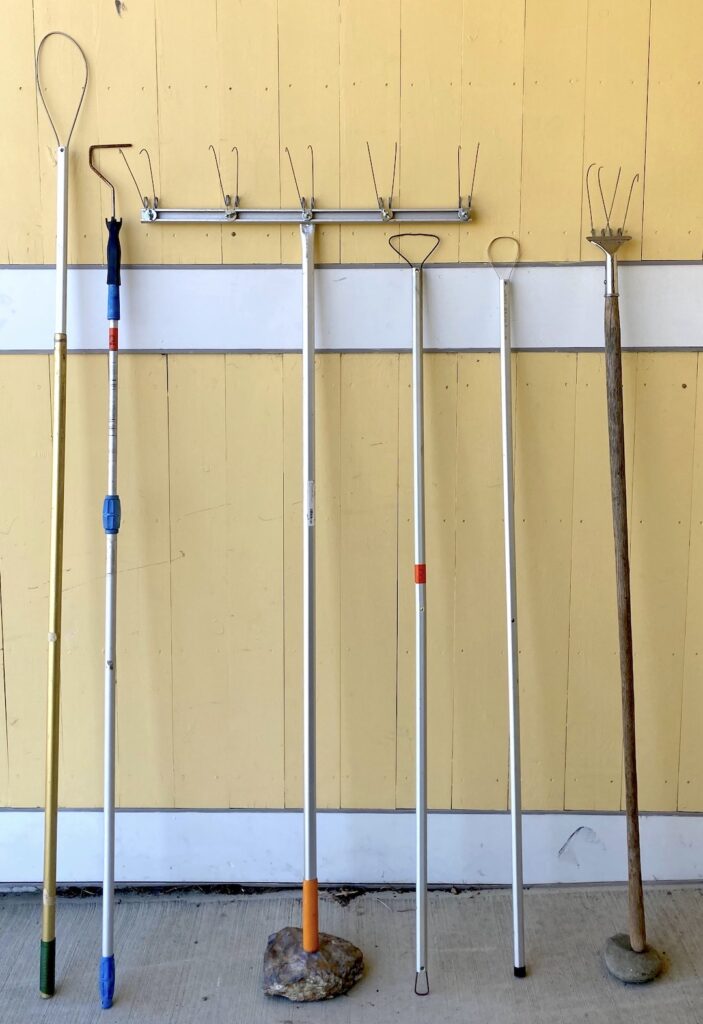
Needs Vs. Wants
This is an overarching theme in my desire to stimulate people’s interest in creating their own useful tools. What do you really need? Are you a commercial farmer or have the desire to be one? Can you get by with less? You can often buy a high-quality tool, at a fairly high price and it will last (usually). Will it fit you comfortably, enhance your work output and add to the pleasure of working the land? With all of the hand tool options available today, what would you choose and how do you arrive at those choices? I think that it’s really unfortunate that one cannot “test drive” most of these tools. They may look good in a catalog or showroom, but will their cost be justifiable?
No-Restraint Design
Some of my creations are simple variations to or slight modifications of existing tools. One of my design principles is that anyone should be able to inexpensively replicate these tools. The other is that one should go unabashedly to the absurd, investigate the potential there, and then back off to embrace something a bit more practical, although often less comical. It helps to fail with a smile, but such a setback also has the potential to launch one into new areas of discovery. That “Eureka” moment can happen when you let go of trying to get it “right” the first time.
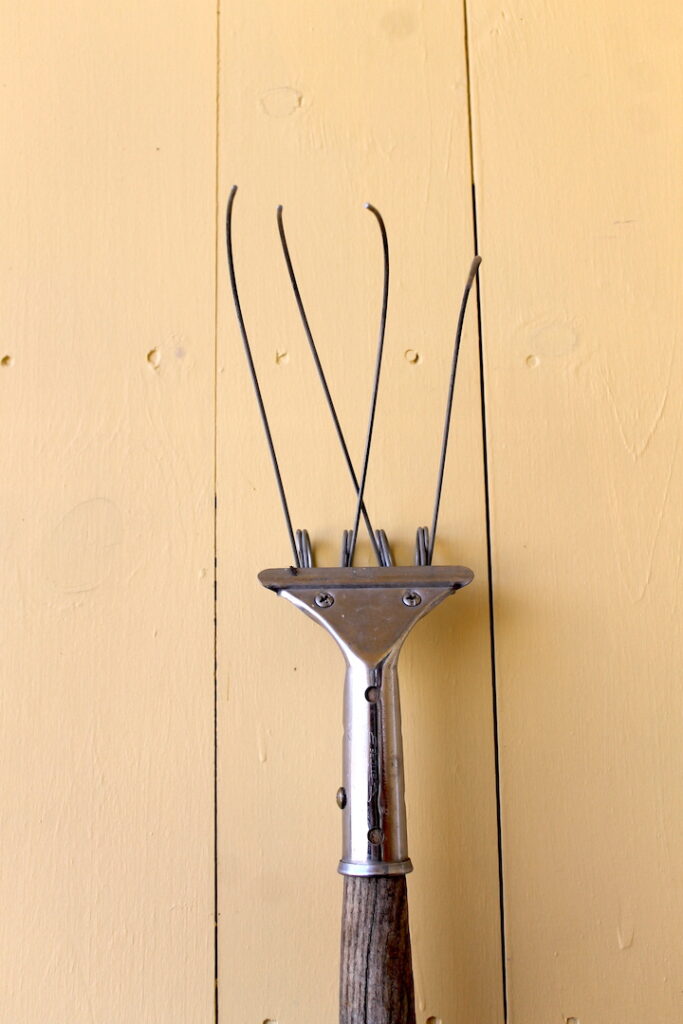
Junk
It also is good to be “cheap,” scouring handles and parts from roadside castoffs, yard sales, or from friends who are downsizing. Thomas Edison is attributed to the following statement: “To invent, you need a good imagination and a pile of junk.” Even if I don’t qualify as an inventor I think that carrying forward both of those aspects takes me down some fun paths. This “junk fool” diet is something I am reluctant to drop. (I do have my detractors though, mostly coworkers.)
Wire
Wire is a key component to making wire weeders. While there may be a plethora of wire with various size, strength and integrity available for use, I haven’t delved much into exploring. I find that earth staples, those “U”-shaped wires made to hold down landscape fabric, are pretty adaptable. The type of row cover wire sold as straight pieces, rather than the pre-curved ones that seem overly flexible, also works fairly well. The small amount of springiness in this material helps it hold its shape. Another option is metal leaf rake tines. Their flat cross section lends a more aggressive, slicing action for weed control. A final option is the wiggle wire used to hold plastic in place on greenhouses. It is quite difficult, but not impossible, to reshape. Pieces of these can often be found around farms. The wire is stainless and very durable and stubbornly tenacious.
Ergonomics
I often ask myself questions about ergonomics when considering design. Why aren’t there more tool handles that would accommodate people of various heights and muscle masses? Couldn’t there be different setups for favored and more comfortable hand positions? What if handles could be extended or retracted, be light yet sturdy, and not delve into the realm of carbon fiber technology?
To that end, I have played with various handles, including retrofitting adjustable paint roller handles, to enable a change of shaft length. More recently, I have become obsessed with collecting randomly picked up walking sticks. Free handles, custom-grown, with wonderful patina — it simply doesn’t get much better than that. It is pretty cool to note how these natural shafts speak. Their slight or exaggerated curves may lend a more ergonomic grip or make for a wrist biter, it is something your body will tell you.
Light Soil and Small Weeds
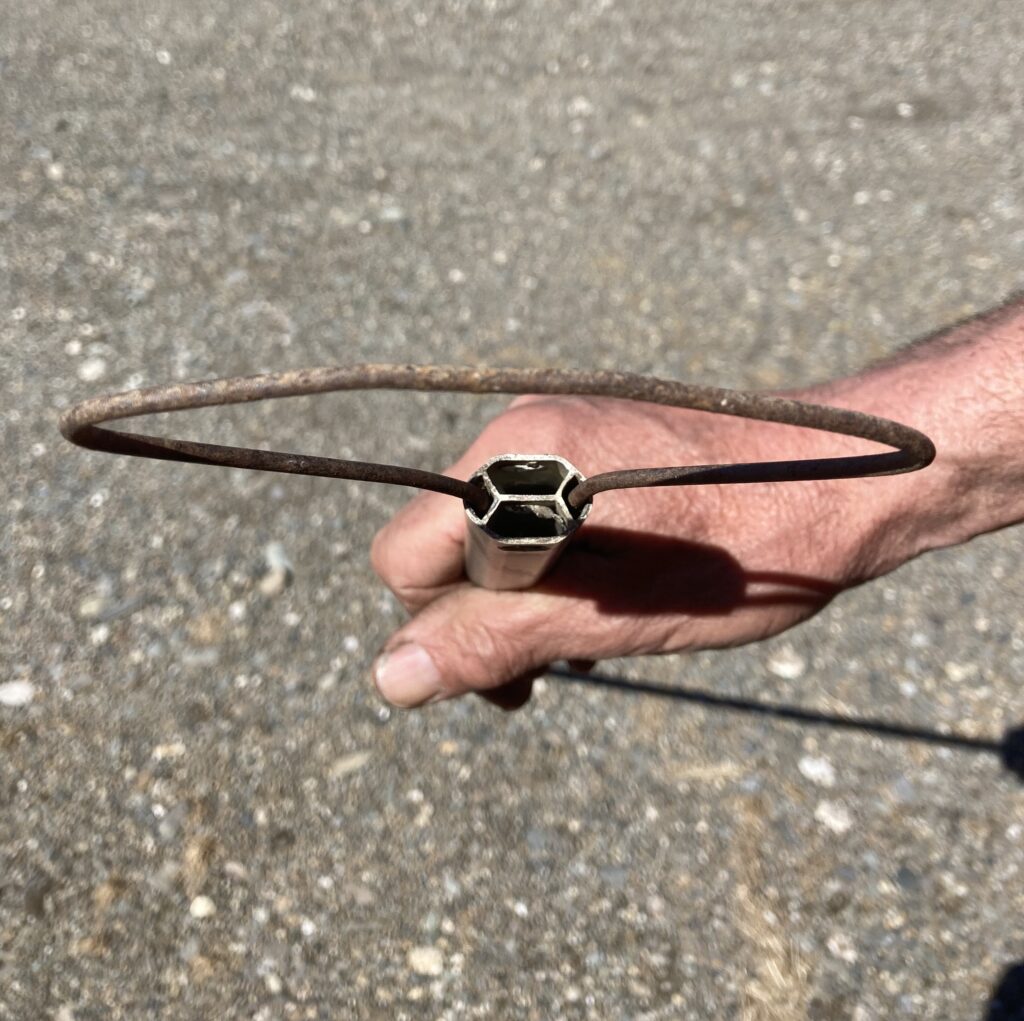
While the soil on the MOFGA grounds is a stone-free, sandy loam that makes for a less punishing environment for cultivating tools, it should be noted that these tools are best suited for shallow and frequent cultivation, especially when weeds are at the tiny “thread stage.” Some of the ideas behind these are indeed “hacks” (in the small-farm community vernacular, this represents a DIY approach), but they aren’t meant for hacking at large, entrenched weeds. Weed early and often and your body will thank you.
DIY Wire Weeder Components
After a wind-contested Common Ground Country Fair, here at MOFGA we can expect a few pop-up canopies to get damaged. While some of the parts can get swapped out and used to build up another canopy, I usually salvage a few to use as lightweight hoe handles. A few of these canopy designs have an internal chamber with cross pieces that allow one to easily insert a wire where it will remain in place. Those earth staples fit well here and crafting a triangular configuration is relatively easy. Lightweight, functional and cheap — that’s a few boxes checked off on my list. You can add another sculpted wire to the other end, for a double-ended tool, and if the wire loop is kept small, it can provide an option to let you weed in some pretty narrow spaces. Leaf rake tines will also conveniently slip into the honeycomb-like lattice of these poles. While these poles are pretty small in diameter, I don’t find them to be that uncomfortable when in use. You could probably add a foam grip, or just some tape, to increase the level of comfort.
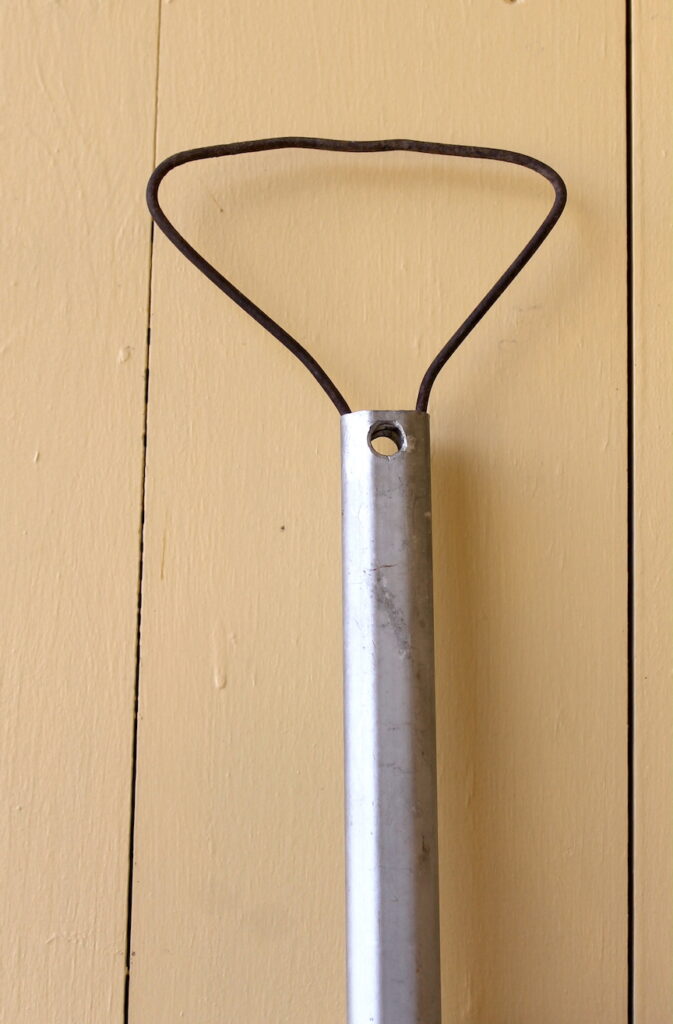
If you don’t have access to such poles, there are several options. Two holes drilled into a wooden pole or a stick will accept the staples. A 3/4-inch electrical metallic tube (EMT) coupler might be just the ticket for firming up that end and securing the wire — or try using an adjustable hose clamp.
Most any aluminum pipe will accept the row cover hoop wire. I have used old tent poles. Even when sticking out at about 10 inches in length, the material seems robust enough to tackle any light weeding. Be aware that aluminum can taint your hands with a grayish film. I recommend applying some tape or foam material to the handle, or wearing gloves to avoid this.
Neversink Farm sells their interchangeable Mutineer line of wire weeder heads in a couple of sizes and configurations. I took the challenge from their website and experimented with fastening these onto a variety of wooden poles, including ones straight from the woods. I have several now and reach for the closest one as needed.
Perhaps my greatest “find,” has been utilizing those ubiquitous small paint rollers. Without the roller cages (which can be easily smashed and removed), and attached to a threaded pole, they make an instant copy of those highly esteemed long-handled wire weeders. (There is a coating on these of unknown content and you may want to sand or grind it off.) There’s no need to flatten or sharpen this round stock, they work well as is.
More pleasure might be found using an adjustable pole, allowing you to set the length to your preference while adding a coolness factor. These are rather fun to use in working around established plants, are quite sturdy, and can be worked right under drip tape with no problem. If the wind lifts your tape, they are also helpful for resetting it back in the row.
I have experimented with using wiggle wire, and with some effort made a passable in-the-row torsion weeder. You can just drag it over plants. With any luck, you will have disturbed the weeds and not uprooted your intended crop.
A flexible-tine Groundskeeper Rakehas been utilized by some folks for “blind weeding,” where you basically drag the rake right over your established plants and hope for the best. With the right timing, this can disrupt a new flush of young weeds and still leave you with a crop. I bought some replacement tines to mess around with. I have had success attaching them to squeegee heads that easily accept a pole. This makes for a small unit that can also work by using a side-to-side sweeping motion. I made a larger unit by fastening five tines to a piece of wiggle wire channel using washers and wingnuts. I have used it to rake loose hay as well as using it as an in-row cultivator. The handle can be pivoted, almost professional-like in its adaptability.
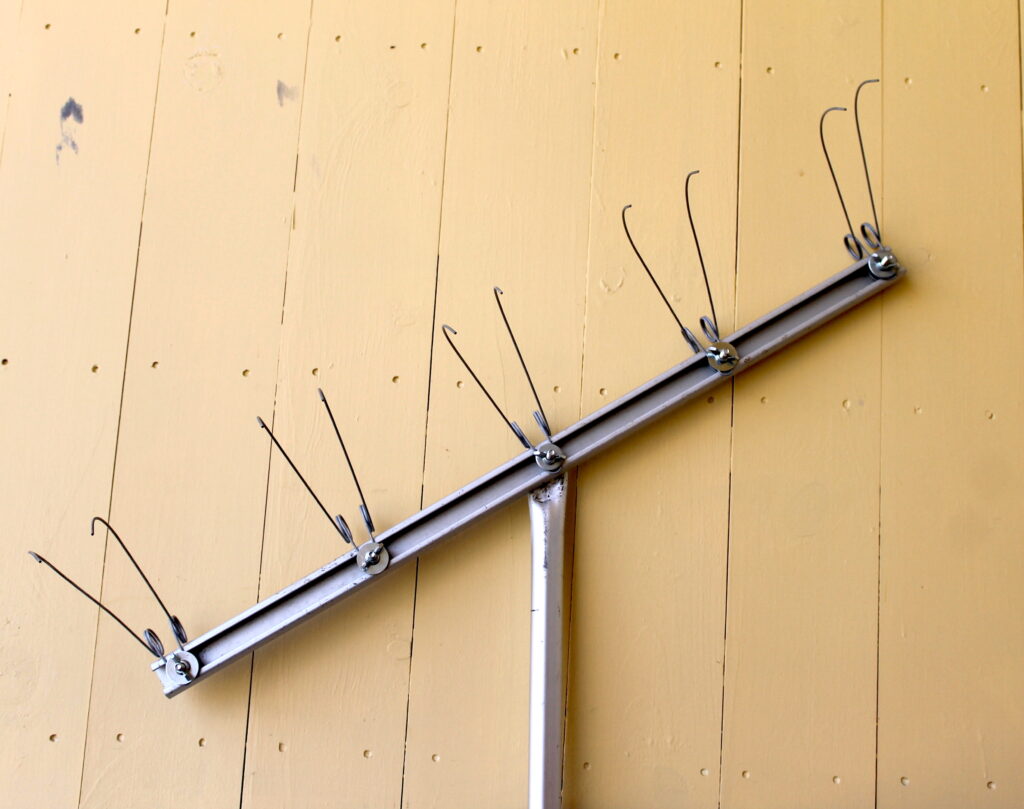
If you think all this is just a little too bizarre, take a look at video footage of Dr. Eric Brennan, someone I draw inspiration from. He works with commercial California growers with large crews that need to weed the edges of plasticulture-encased strawberry beds and has designed an inexpensive double-ended strap hoe. His performance outlining the design is not to be missed.
Interested in learning more or trying out any of these designs? Do you have feedback you would like to share? Reach out to [email protected].
This article was originally published in the summer 2022 issue of The Maine Organic Farmer & Gardener.
